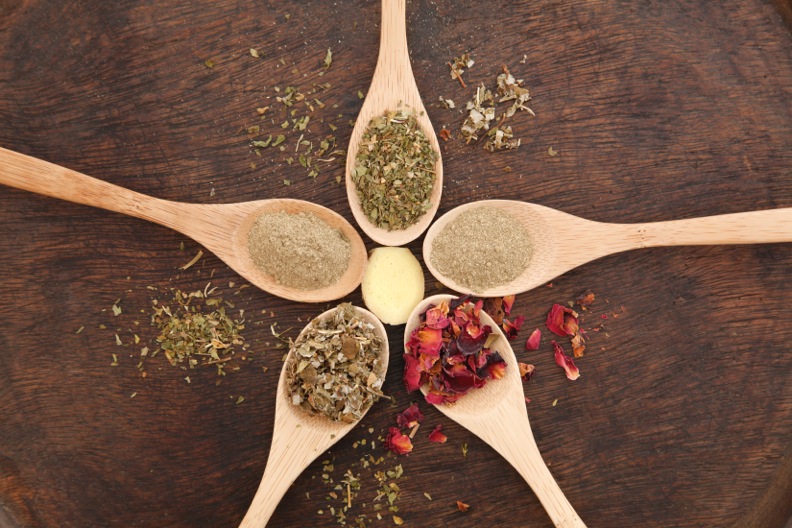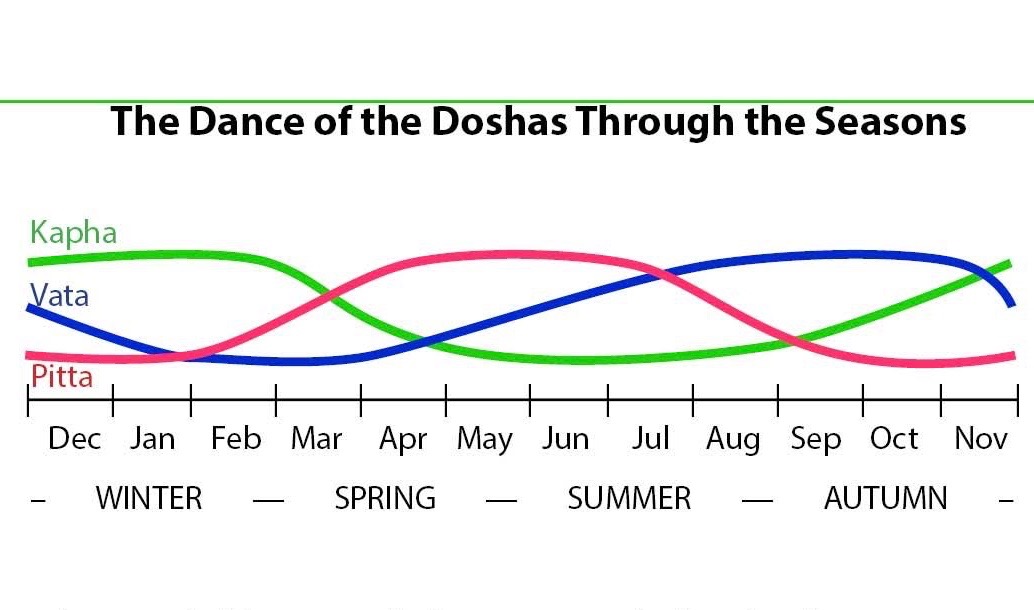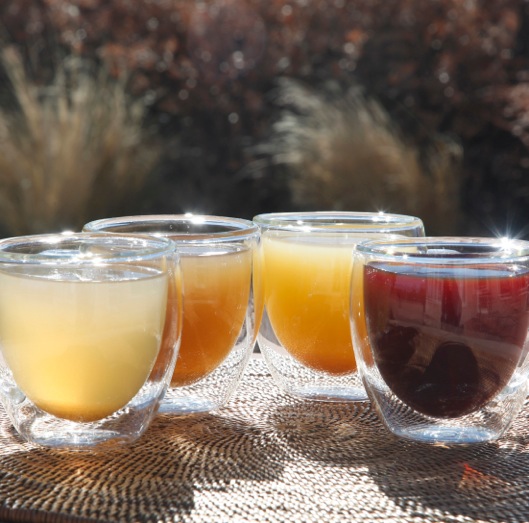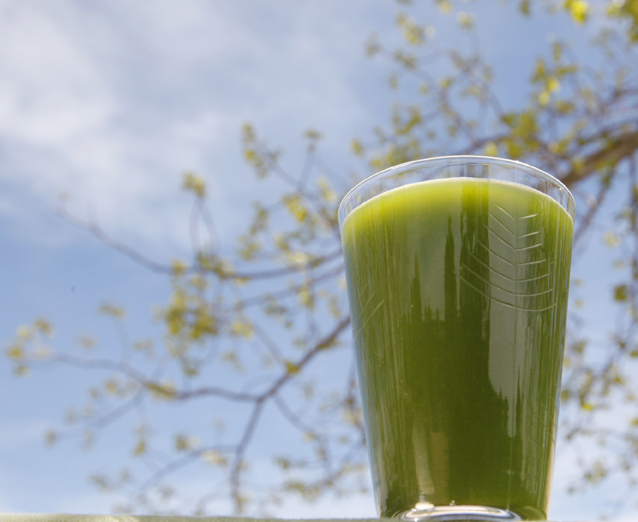
Ayurveda Late Winter Spring Fare:
Eating with the Season & Your Doshas
Discovering what Ayurveda late winter spring fare is just right for you can take some self examination. Not everyone responds to late winter or early spring in the same way. A lot depends on the balance of your doshas.
The Doshas Change with the Seasons
Ayurveda tracks the rise and fall of the biological energies of the doshas through the seasons. Depending on what doshas are most prominent in you right now, you can eat just right for you – yet you might need something different than a close friend or loved one. How to discover what you need, and be able to pull it off?
Kapha in Late Winter to Spring
Looking at The Dance of the Doshas chart below, notice how Kapha, the green line, runs high in the winter months. This means that the cool, heavy, slow, damp conditions of Kapha still predominate in nature. If Kapha dosha is also high in your body right now, you may be having a hard time getting out of bed or struggling with sinus congestion. You may crave heavier foods, yet when you eat them, you feel stuporous or your gut rebels. Kapha when stressed can get sad, depressed, or withdraw. Notice that in the coming month Kapha starts to dip substantially; the scene is going to lighten up.

Using the gunas, the qualities of life, with awareness
Ayurveda applies opposite qualities to come into a natural balance that feels good. Working with the gunas, you create meals just right for you. You may know that you need a walk (mobile, fast) to break through the sluggishness (slow) of this moment, yet maybe all you can muster is a light warm cup of tea to start. You pick the healing qualities you’re ready to introduce – with Kapha, these are light, warm, mobile, lively.
Ayurveda Late Winter Spring Fare for Kapha
A beverage that strongly calms Kapha (and Pitta) is Green Dino Detox Tea. Highly appropriate as light warm Ayurveda late winter spring fare, you can use it both to ground and enliven yourself, Get a jump start on spring cleaning. It’s a veggie tea recipe found in the winter eBook and the 4-seasons color print book Easy Healing Drinks from the Wisdom of Ayurveda by Morningstar & Lynn.

GREEN DINO DETOX TEA
Time: a leisurely 15 minutes
Makes 3 (1 cup) servings
1 quart + ½ cup water
1 bunch Lacinato (dinosaur) kale
1 thin slice onion
1 slice (2 inches) fresh lemon
1 inch slice fresh ginger
½ teaspoon ground tulsi
OR use 1 Organic India brand Tulsi lemon ginger tea bag instead of the lemon, ginger, and tulsi
Bring the water to a boil. Tear the kale off the stems into the water, discard the stems or save for a soup stock. Add the rest of the ingredients; simmer until greens are tender. Strain, using the steaming water as your drink. Use the greens in whatever dish you like. (You could serve them with extra virgin olive oil and a splash of lemon or vinegar.)
Effects: neutral Vata, strongly calms Pitta and Kapha.
This detox tea supports: plasma, red blood cells, muscle, bone, liver. Alkalizing.
Compliments Easy Healing Drinks from the Wisdom of Ayurveda, Morningstar & Lynn
More Ideas for Ayurveda Late Winter Spring Fare for Kapha
Well-spiced teas, brothy soups, creamy soups made with plant ingredients instead of dairy, steamed veggies and stir fries, steamed salad bowls, simmered foods not fried: all support you bringing Kapha into balance. Light clean proteins like red lentil dal, scrambled tofu, kichari with quinoa, plant seed milks are important to stabilize energy. Kapha can think creatively, having a plant-based pesto sauce on steamed veggies instead of pasta, for example. If you do well with an animal protein, honor that and use it in moderation.
Pitta in Late Winter to Spring
Not everyone is feeling sluggish now. Check out the rising red line that is Pitta dosha in February in The Dance of the Doshas chart. As Pitta rises, it’s ready for take off in spring. You may be feeling this already: warm, assertive, perhaps even a little restless. When Pitta is strong in the season or our constitution or in our current condition, warm, assertive, sharp, focused, oily qualities arise. Under stress Pitta can head for anger, irritability, impatience. Yet maybe you’re quite balanced, just warm and focused. You can feel this warmth inside you, in your body and your mood.
Location as It Relates to Ayurveda Late Winter Spring Fare
Pitta is likely to be stronger, and spring closer, the further south in this hemisphere you go. People living in San Antonio, Miami, and Tucson are already experiencing this rise in Pitta. If you live in Bozeman, MT or Burlington, VT you are still in the Kapha throes of late winter. Just as you need to dress according to the weather, it’s smart to eat according to the temperatures. The calendar may be pushing toward spring, yet if you’re looking at snow drifts outside, hold off on the salads until you can feel the warmth.
Ayurveda Late Winter Spring Fare for Pitta
If you’re feeling the warmth already, it’s time to introduce more spring fare, including more raw spring greens and slightly cooling foods. Try the following recipe, compliments of Easy Healing Drinks from the Wisdom of Ayurveda spring cleanse eBook & the 4-seasons print book . On the other hand, if just looking at this drink makes you chilly, wait a month or two before you adventure down this path.

COOLING COCONUT GREEN DRINK
Time: 10 – 15 minutes
Makes: 1 cup
1/3 cup well-packed cilantro, finely chopped
½ – 1 teaspoon or more finely chopped fresh ginger, peeled
1 Tablespoon fresh lime juice
1 cup organic coconut water
1 teaspoon coconut sugar (optional, see Variations below)
½ cup or more dark leafy greens of your choice
Pre-pulse the cilantro, ginger and lime juice until they are as smooth as possible. Add the coconut water and coconut sugar; blend until smooth. Now it’s time to play: blend in as much of your favorite greens as you like. Enjoy!
Effects: very calming to Pitta, calms Kapha. Raw greens increase Vata, although the ginger, lime and fluid all make it less aggravating. Yogurt or coconut milk (see variations below) are other ways to calm Vata.
This drink supports: plasma, blood cells, muscles, immunity.
Note: This magnesium-rich Pitta and Kapha subduing drink is an improvisation on Mataji Desai’s Gujarati Fresh Coriander Chutney in our Ayurvedic Cookbook. This is an example of how to Adapt a Recipe for a specific season.
More Ideas for Ayurveda Late Winter Spring Fare for Pitta
We’re still talking Ayurvedic classics like red lentil dal, basmati rice, tofu, and steamed veggies. Also veggie soups, bean pates and pestos, quinoa tabouli, veggie wraps, light pastas – and some salads. Kate O Donnell’s great idea of steamed salads is especially perfect at this transitional time of year, even for Pitta. They’re easy to digest, and help you keep your cool. Joyful Belly has an encyclopedic list of Ayurveda proteins if you’re seeking inspiration.
What about Vata in late winter spring?
Check out the blue Vata line in The Dance of the Doshas chart. Notice how low that line is in February. Vata is as calm as it ever naturally gets. You may feel more grounded, less worried than usual, despite the chill still in the air. You still need to tend to moisten any dryness. Vata dosha qualities are dry, cool, light, mobile. Applying the Ayurveda wisdom of opposites, warm moist gently spiced foods are likely to feel just right for you now. Taking more time, not pushing yourself. Vata stressed can worry or get anxious. Making sure to have regular meals can help.
For Vata, navigating late winter can be its own pleasure. I find myself heading for still-warming gluten-free grains like buckwheat and sorghum, knowing that once spring comes, I’ll have them less. Sustaining foods can provide welcome grounding for Vata. Dealing with the last of chill winter or piercing breezes, warm food is considered wise at this time not only for Vata, but most healthy eaters.
Meal Frequency: Navigating the Weather as Well as the Season
Just as I’ve written these encouraging words about Vata, the winds kick in here: cold, bitter, restless. All the more reason to make sure you’re protected, warm, well-fed with regular meals. Vata of all the doshas is most likely to skip a meal, and least able to weather this tendency well. While Kapha does well with two meals a day (lighter, yes), Vata and Pitta need a steady three meals per daily whenever possible.
In this frame of mind, and influenced by my mother’s German ancestry, I set out to make dumplings a few nights ago. While gluten-free and vegetarian, they were not 100% plant-based. The ingredients:
GLUTEN FREE SORGHUM DUMPLINGS FOR VATA
Serves 4
1 cup sorghum or buckwheat flour
2 teaspoons baking powder
1 teaspoon xanthum gum
½ teaspoon salt (or less)
1 egg
Some milk or plant milk (see directions)
1 Tablespoon finely chopped parsley or fresh basil
Lightly whisk together the dry ingredients in a mixing bowl: the flour, baking powder, xanthum gum, and salt.
As per Joy of Cooking, crack one egg into a 1-cup container and beat it, then pour enough whole milk in to come to the “1/2 cup” mark. (If you want a vegan recipe a flax egg and a plant milk could work, depending on your inclinations. They are likely to be a little stickier.)
(The potted basil plant in the corner, a survivor of last year, kindly let me pick a generous tablespoon’s worth of fresh leaves. I chopped those finely, and set them aside for a moment: 1 Tablespoon fresh basil or parsley)
Pour the liquid into the dry ingredients in the mixing bowl, toss in the fresh basil, lightly stir them all together, to a drop biscuit consistency.
I had made a big pot of Ayurveda late winter spring fare soup with root veggies and greens:
BASIC VEGGIE SOUP
Makes 3 quarts
2 quarts water
pinch of salt (optional)
1 carrot (whole)
½ onion (whole)
2 bay leaves
1 cube low-sodium veggie bouillon
Bring these to a boil in a soup pot while you prep the veggies. Then reduce the heat to simmer and cover the pot. You can use whatever veggies appeal to you, or that are on hand. One root and one green are just fine, if you want to keep it simple. Here’s some choices:
2 – 4 cups roots, cubed (carrots, onions, leeks, parsnips, turnips, beets, or daikon)
2 – 4 cups greens, chopped (kale, broccoli, arugula, spinach, Chinese cabbage, or whatever digests well for you)
1 – 2 thin slices of ginger, well-chopped (optional, nice for digestive fire)
Add these to the pot, plus
1 teaspoon ground cumin
1 Tablespoon ground coriander
Simmer until it smells good and the veggies are tender. Remove the carrot and onion used for the stock.
For dumplings, the soup needs to be brothy, rather than thick and stewish. Here it’s best to use the smaller amount of veggies, rather than the larger amount, so the soup is thinner.
Lift the lid to the steaming soup, and immerse a clean tablespoon in the broth. Use this tablespoon to scoop up a tablespoon of the dumpling batter and gently place it on the steaming surface of the soup. Immersing the spoon in the broth again, between each dumpling, spoon each little “lumpling” on to the soup. Cover the pot and leave them to steam for ten minutes. They’re best eaten immediately.
Typical serving size: Vata 2 – 3 (2 inch) dumplings, Pitta 3 – 4 dumplings, Kapha 1 – 2 dumplings.
Dumplings are a quick healthy warming gluten free carb in chill weather. If you don’t need 4 servings, do feel free to cut the recipe in half. Dumplings are best served light, fresh, and warm. They’re not your optimal left over, as they quickly can get cold and heavy.
This is a particularly seasonal recipe for Ayurveda late winter spring fare. In summer, dumplings would feel too heavy and warm. They’re seasonal fare, to be enjoyed when it makes sense.
More Ideas for Ayurveda Late Winter Spring Fare for Vata
One pot meals, hearty soups, dal, rice, veggies for sure, soupy kichari for sure (as well-tolerated), steamed salads heavy on the proteins (and grains, if your body works with these well). Classic Ayurveda fare works well for Vata this time of year.
Ideas for Ayurveda Late Winter Spring Fare for Everyone
For more seasonal approaches, check out the recipes in Easy Healing Drinks, Ayurvedic Cooking for Westerners and The Ayurvedic Cookbook. You can toggle back and forth between the Winter and Spring menus, see what appeals, given the qualities you notice in you. If you’re up for Some Work On Your Own, check out p. 303 in Ayurvedic Cooking for Westerners. There’s a relaxed process for looking at what you need now to make your food just right for you.
PS: Ayurveda Late Winter Spring Fare: the Wheat and Dairy stories
Ayurveda considers wheat cool, damp, and sticky, perfect for grounding Vata and Pitta, yet increasing to Kapha. Kapha being high at this time of year, minimizing wheat can help this dosha come back into balance. A substantial number of Vata and Pitta constitutions in the US also find wheat difficult to digest. If you’re among them, you may seek out gluten free recipes, like the one I just gave. Yet Dr. John Douillard is an Ayurvedic practitioner who’s pioneered being able to reintroduce wheat into one’s diet. He has some great approaches.
Similarly, dairy tends to be heavy and support a build up of Kapha. Ayurveda cuts cold damp dairy with spices: cinnamon and ginger for hot milk or yogurt, pippali or black pepper or basil with cheeses. One option is to pulse your usage, backing off if you’re congested, enjoying as you can.
Tridoshic Ayurveda Late Winter Spring Fare
If you choose foods that are warm, lightly steamed, in proportions suited to you, you are likely to be able to keep all three of your doshas happy. There’s still time for soups and stews, yet you could find brothy soups suit you better than creamy thick ones. If you have a strong amount of Pitta, you could be ready to add raw salads. Yet in moderation.
A friendly beverage that suits all your doshas can help you move through this cuspy season. With Internet Recovery Tea, all the qualities to calm all three doshas are present. It’s supportive of the nervous system and you can drink it year-round as needed. Here’s the recipe, compliments of Easy Healing Drinks from the Wisdom of Ayurveda , Morningstar & Lynn.
INTERNET RECOVERY TEA
Take a break from the internet and Smart phones to heal any dosha, especially Vata and Pitta. If the 24/7 quality has lured you in, to the detriment of your nervous system and basic sanity, consider turning the web off and having a cup of this tea to reset your wisdom link. If you can get yourself out in nature as you drink it, all the better. Enjoy!
Time: 20 minutes
Makes 2 quarts = 8 cups
2 quarts water
1 Tablespoon raspberry leaf (or 1 raspberry leaf tea bag)
¼ cup rose petals
2 Tablespoons dried peppermint (or 2 peppermint tea bags)
1 Tablespoon dried brahmi (Bacopa) *
2 teaspoons shankhapushpi powder *
1 thin slice of fresh ginger root
In a medium stainless steel saucepan, bring the water to a boil. Add all the herbs, stir, turn off the heat, cover. Infuse for five minutes or until it smells friendly. Strain immediately.
Unlike many of the teas here, this is an infusion rather than a decoction. If you like your tea stronger, let it sit until it is the flavor you enjoy. Watch out though! It can get bitter the longer it rests. Drink up to 2 cups per day as needed. Sweeten with honey if you like.
Effects: tridoshic, calms Vata, Pitta and Kapha beautifully.
This therapeutic tea supports: the nervous system in particular; in addition, plasma and female & male reproductive systems.
Comments: Brahmi/bacopa is a time-honored way to revive mental clarity and memory, and Shankhapushpi is unrivaled in its ability to calm over wrought nerves without a heavy sedative effect. For those of us with very aware nervous systems, it can help us relax. Banyan Botanicals is a good source for shankhapushpi and bacopa (LINK). While neither of these has none contraindications, caution would be advised with anti-epileptic, anti-depressant, or sedative medications, as these are their traditional uses (Pole).
VARIATION: If you haven’t got shankhapushpi or bacopa, use an equal amount of lemon balm (Melissa) in place of either of these two.
VARIATION: Some people with acid reflux do better without mint. If you are among them, simply leave the peppermint out of this formula; you can add an equal amount of extra raspberry or tulsi tea.
Late February weather in the Northern Hemisphere can be tough and uninviting. Yet surprisingly, sometimes in the very same day, the sun touches your face, a bird sings, and you can feel that spring is near. How do you want to eat healthfully during this late winter spring season?

Internet Recovery Tea ingredients, Veggie Teas, Cooling Green Drink images all thanks to Renee Lynn.
The Dance of the Doshas chart thanks to Elizabeth Carovillano.
“Eating just right” inspiration thanks to Andrea Lites Perry.
Any errors in this blog are my own.
If you are interested in learning more about how to apply the gunas, qualities, to healthy eating, especially for Autumn – Winter or Vata, Adapt Recipes On-Demand course with Amadea is the course for you.
Special 50% off Sale on Adapt Recipes On-Demand course with Amadea for Autumn-Winter, thru Feb. 29, 2024. PACE certified.
Amadea Morningstar has worked with food, energy and healing for 50 years, and with Ayurveda for 40 of these. She’s the founder of the Ayurveda Polarity Therapy and Yoga Institute in Santa Fe, New Mexico, and an internationally recognized author and teacher in the field of Ayurveda. Her most recent book is Easy Healing Drinks from the Wisdom of Ayurveda. Amadea has a private practice in Santa Fe, New Mexico, offering Ayurvedic nutrition, marma chikitsa, lifestyle education and Polarity Therapy. It is her joy to work with ordinary people from a variety of backgrounds, culminating in the Adapt Recipes course.
